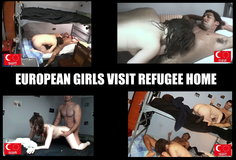You are using an out of date browser. It may not display this or other websites correctly.
You should upgrade or use an alternative browser.
You should upgrade or use an alternative browser.
Help for refugees.
- Thread starter Marusialt
- Start date
Perfect for Cuckbois in castity like me! I am the servant!
Last edited:
I think you’re on the wrong site. It’s called black on white mate. It’s about black foreign migrant Muslim cock entering your wives white pussy.Creating mudslide offspring for your paedo prophet.
Poland and Hungary are the only European countries to get it right.
Why are you here? You should be protecting our shores.
@SeanS Get over their quick Sean. Protect the white women!This is how white women should welcome migrants into your country. Welcome them with open legs and let them conquer your with their cocks.
The EU returns to work on the migration pactIn 2020, work began on the regulation on asylum and migration management. It has, among others: aimed at replacing the first country of entry criterion with a relocation system.Currently, the European Union rules that a migrant must apply for asylum in the first Member State into which he or she enters. In practice, however, this burdens the Mediterranean countries that are closest to the war zones in Africa and the Middle East.The new solidarity mechanism is intended to ensure a fair division of responsibility between all Member States, not just those in southern Europe.The idea of a common EU migration policy has been in existence since 2009, when the Treaty on the Functioning of the European Union entered into *******. Work on creating this regulation accelerated around 2015. At that time, a migration crisis began with the arrival of large numbers of refugees from North Africa and the Middle East to Europe (especially southern Europe)."Penalties" for not accepting migrantsMigrant relocations have been talked about since the beginning of the migration crisis. In September 2015, the Council of the EU adopted a decision on a temporary mechanism for the relocation of migrants from Italy and Greece to other member states. Slovakia (still under PO government) agreed to accept approximately 5,000. people.Ultimately, however, it did not accept the migrants. This resulted in a case before the EU Court of Justice (1, 2).In the summer of 2022, the idea of establishing a voluntary solidarity contribution mechanism emerged. It would include relocations or other types of contributions, especially financial ones.In recent weeks, there has been a lot of talk about the relocation system being subject to fees for not accepting refugees. On June 6, Politico wrote that the proposed amounts range from PLN 10,000. and 22 thousand euro. This information was supposed to come from EU diplomats taking part in work on the package.Two days later, on June 8, the member states agreed on their negotiating position regarding, among others, regulation on asylum and migration management. This does not mean that the regulation enters into *******. The adopted position is only the basis for negotiations between the Council Presidency (currently held by Sweden) and the European Parliament.What is the solidarity mechanism?What does the EU Council propose? First of all, it points to the need for greater solidarity between EU countries in managing asylum policy. The official statement reads:“There will be a minimum annual number of relocations from the Member States through which most people enter the EU to Member States where this occurs less frequently. This number will be 30,000 and the minimum annual amount of financial contributions will be EUR 20,000 per relocation. The number and amount may increase if necessary; "The situation will also be taken into account when there is no need for solidarity in a given year."In other words, the EU Council wants to introduce a refugee relocation system. Member countries that are less burdened by the migration problem will have to accept a total of at least 30,000. foreigners.The number of migrants per country will be calculated using a special formula, depending on population and GDP (p. 148). Slovakia should accept approximately 2,000. people. For each unconsidered application, the state will have to pay a fee of PLN 20,000. euro.
Making Germany and the rest of Europe a third world continentThe hard and pleasurable satisfaction of welcoming the newcomer
View attachment 6950785
The EU should be disbanded, sovereignty restored and the borders closed. These people passed through how many countries on their way to Europe? Poland and Hungary are the only intelligent countries in Europe.The EU returns to work on the migration pactIn 2020, work began on the regulation on asylum and migration management. It has, among others: aimed at replacing the first country of entry criterion with a relocation system.Currently, the European Union rules that a migrant must apply for asylum in the first Member State into which he or she enters. In practice, however, this burdens the Mediterranean countries that are closest to the war zones in Africa and the Middle East.The new solidarity mechanism is intended to ensure a fair division of responsibility between all Member States, not just those in southern Europe.The idea of a common EU migration policy has been in existence since 2009, when the Treaty on the Functioning of the European Union entered into *******. Work on creating this regulation accelerated around 2015. At that time, a migration crisis began with the arrival of large numbers of refugees from North Africa and the Middle East to Europe (especially southern Europe)."Penalties" for not accepting migrantsMigrant relocations have been talked about since the beginning of the migration crisis. In September 2015, the Council of the EU adopted a decision on a temporary mechanism for the relocation of migrants from Italy and Greece to other member states. Slovakia (still under PO government) agreed to accept approximately 5,000. people.Ultimately, however, it did not accept the migrants. This resulted in a case before the EU Court of Justice (1, 2).In the summer of 2022, the idea of establishing a voluntary solidarity contribution mechanism emerged. It would include relocations or other types of contributions, especially financial ones.In recent weeks, there has been a lot of talk about the relocation system being subject to fees for not accepting refugees. On June 6, Politico wrote that the proposed amounts range from PLN 10,000. and 22 thousand euro. This information was supposed to come from EU diplomats taking part in work on the package.Two days later, on June 8, the member states agreed on their negotiating position regarding, among others, regulation on asylum and migration management. This does not mean that the regulation enters into *******. The adopted position is only the basis for negotiations between the Council Presidency (currently held by Sweden) and the European Parliament.What is the solidarity mechanism?What does the EU Council propose? First of all, it points to the need for greater solidarity between EU countries in managing asylum policy. The official statement reads:“There will be a minimum annual number of relocations from the Member States through which most people enter the EU to Member States where this occurs less frequently. This number will be 30,000 and the minimum annual amount of financial contributions will be EUR 20,000 per relocation. The number and amount may increase if necessary; "The situation will also be taken into account when there is no need for solidarity in a given year."In other words, the EU Council wants to introduce a refugee relocation system. Member countries that are less burdened by the migration problem will have to accept a total of at least 30,000. foreigners.The number of migrants per country will be calculated using a special formula, depending on population and GDP (p. 148). Slovakia should accept approximately 2,000. people. For each unconsidered application, the state will have to pay a fee of PLN 20,000. euro.
Submissivedude
Male
Oh my god its fucking hot and I would be gratefull to lick my Wife clean after she been fucking them. I could be the bitch husband on the flor by the bed.
Submissivedude
Male
its hard for me to say this. But if my cuckoldres Wife fuckes this dudes Im happy to do cleanupp and I even be happy to clean up with my mouth bouth her and her refuges Bulls! Feel that verry humiliating but cant help my self from submitting! She know that Im her bitch so I have no choice!
Happy Hour at the Aloha Snackbar
I think you'd be a lot happier if you just accept we've been conquered rather than posting racist comments on a board for black men and white womenHappy Hour at the Aloha Snackbar
I think you'd be a lot happier if you just accept we've been conquered rather than posting racist comments on a board for black men and white women
Attachments
Similar threads
- Replies
- 0
- Views
- 435










